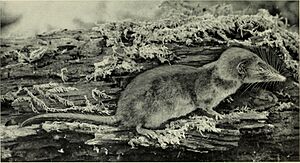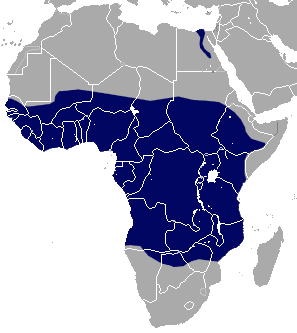African giant shrew facts for kids
Quick facts for kids African giant shrew |
|
|---|---|
 |
|
| Conservation status | |
| Scientific classification | |
| Genus: |
Crocidura
|
| Species: |
olivieri
|
 |
|
| African giant shrew range | |
The African giant shrew (Crocidura olivieri) is a type of white-toothed shrew. It is also known by other names like Mann's musk shrew or Olivier's shrew. This animal lives in Africa and can be found in many different places. It lives in forests, savannas, farms, gardens, and even cities. In some areas, like the Nile Valley, it lives close to people and is sometimes seen as a pest. This shrew is quite common, so it is listed as a species of "least concern" by the International Union for Conservation of Nature.
Contents
About the African Giant Shrew's Name
This shrew was first discovered from mummified bodies. These ancient shrew mummies were found in Ancient Egyptian tombs at Sakkara. The scientists who found them first thought they belonged to a different group of shrews.
The official scientific name for this animal is Crocidura olivieri. Even today, large shrews like these live in Egypt. Scientists believe the lost original specimen looked very much like the shrews living there now. Although there are different colors and types of these shrews, they are all part of the same species.
What Does the African Giant Shrew Look Like?
This is a large shrew. Its body, from head to tail, can be about 110 to 140 mm (4.3 to 5.5 in) long. Its tail is usually about 80% as long as its body. Its back feet are about 21 to 23 mm (0.8 to 0.9 in) long.
The weight of the African giant shrew can vary. In Nigeria, these shrews weigh between 37 and 65 g (1.3 and 2.3 oz). But in Zimbabwe, they are a bit smaller, weighing from 31 to 37 g (1.1 to 1.3 oz).
Their fur color can be different. Their back can be reddish-brown, dark brown, or even blackish. Their belly is usually a lighter color, from buffy-brown to dark grey. Their tail is covered with short, thick hairs.
The shrew's skull is strong and a bit flat. It has a long nose, called a rostrum, and a small braincase. Their teeth are big and strong, especially their front teeth (incisors). They also have special glands on their sides that give off a musky smell.
Where Do African Giant Shrews Live?
The African giant shrew lives in the Nile Valley in Egypt. It is also found across a large part of Africa, south of the Sahara Desert. Its home range stretches from Senegal in the west to Sudan and Ethiopia in the east. It also goes south to Angola, northern Namibia, and Zimbabwe.
These shrews can live in many different environments. They are found in both wet and dry places. They live in forests and also in open grasslands called savannas. In Egypt, they can be seen in gardens, farm fields, and near canals. Sometimes, when they live very close to people, they are thought of as a pest.
How Do African Giant Shrews Live?
The African giant shrew spends its time on the ground. It is most active at night, especially just before the sun comes up.
These shrews eat small creatures without backbones, called invertebrates. Their diet includes ants, beetles, millipedes, termites, and spiders. They might also eat dead animals, which is called carrion.
African giant shrews usually have babies throughout most of the year. On average, a mother shrew will have about four babies in each litter.
Many animals hunt the African giant shrew. Owls, like the barn owl, the African grass owl, and the spotted eagle-owl, are some of their main predators. Other small mammals also hunt them, such as genets, mongooses, and wild cats.


